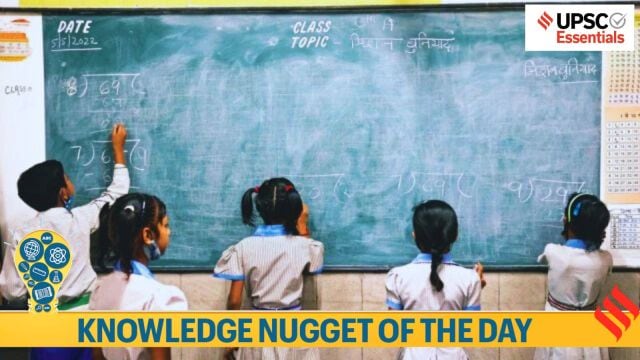
Why in the news?
The Ministry of Education recently released latest assessment of school education indicators, the Performance Grading Index (PGI) 2.0 report for 2023-24.
Key Takeaways :
1. The PGI was introduced in 2017, and the ministry revamped it as PGI 2.0 in 2021. It is an assessment of school education based on 73 indicators, which are grouped under 2 categories, viz., outcomes and governance and management. These categories are further divided into 6 domains:
(i) Learning outcome and quality,
(ii) Access,
(iii) Infrastructure and facilities,
(iv) Equity,
(v) Governance processes,
(vi) Teacher education, and training.
2. The latest report, covering the years 2022-23 and 2023-24, draws data from the National Achievement Survey 2021, the Unified District Information System for Education Plus (UDISE+), and information on the mid-day meal programme (PM-POSHAN).
3. States/UTs are scored out of 1,000 points. In PGI 2.0, the nomenclature for PGI scores is classified into various grades. The highest achievable grade is called Daksh, which is for state/UT scoring more than 90% of the grade range. The details of grades and grade ranges so obtained are:
 The details of grades and grade ranges. (Source: PGI State 2021-22 Report)
The details of grades and grade ranges. (Source: PGI State 2021-22 Report)
4. Notably, no state/UT has scored in the higher ranges of 761 and above. Chandigarh scored 703 points, achieving Prachesta-1 — the highest grade achieved in the latest PGI. Chandigarh scored 703 points, as opposed to 687.8 in 2022-2023, to emerge as the only state or UT in the Prachesta-1 grade that has the score range of 701 to 760.
Story continues below this ad
5. Chandigarh is followed by Punjab at 631.1, and Delhi at 623.7. Kerala, Gujarat, Odisha, Haryana, Goa, Maharashtra, and Rajasthan also scored in the 581-640 range.
6. The state that scored the lowest was Meghalaya (417.9). Just above it were Arunachal Pradesh (461.4), Mizoram (464.2), Nagaland (468.6), and Bihar (471.9).
7. In the middle range of 521-580 (Akanshi-1 grade) were Uttar Pradesh, Tamil Nadu, Karnataka, Andhra Pradesh, West Bengal, Madhya Pradesh, Himachal Pradesh, and Uttarakhand.
8. Referring to the inter-state disparity, the report said, “The maximum and minimum scores obtained by the States/UTs in 2023-24 are 719 and 417 respectively.”
Story continues below this ad
9. The scores are meant to help states/UTs identify areas where they need to make interventions. Of the 36 states/UTs, 25 saw an improvement in their scores in 2023-24 compared to 2022-23.
BEYOND THE NUGGET: ULLAS scheme and PM SHRI
1. Mizoram, Goa and Tripura have attained the “full literacy” tag under Understanding Lifelong Learning for All in Society (ULLAS) – Nav Bharat Saksharta Karyakram.
2. ULLAS – Nav Bharat Saaksharta Karyakram or New India Literacy Programme (NILP) is a centrally sponsored scheme implemented from 2022-2027. It aims to equip 5 crore ‘non-literate individuals’ over the age of 15 across the country with foundational literacy and numeracy skills, which means basic reading and writing and simple arithmetic learnt in primary classes.
3. ULLAS is based on the spirit of Kartvya Bodh and is being implemented on volunteerism. It consists of five components:
(i) Foundational Literacy and Numeracy,
(ii) Critical Life Skills,
(iii) Basic Education,
(iv) Vocational Skills, and
(v) Continuing Education.
Story continues below this ad
PM Schools for Rising India (PM SHRI)
1. It is an initiative run by the Union Ministry of School Education and Literacy. It intends to improve 14,500 schools to “showcase” the NEP, 2020, and be “exemplars” for other schools in their region.
2. The scheme is for existing elementary, secondary, and senior secondary schools run by the central government and state and local governments around the country.
Post Read Questions
(1) Consider the following:
1. Learning outcome and quality
2. Governance processes
3. Access,
4. Infrastructure and facilities,
How many are the domains used for assessment of school education Performance Grading Index (PGI) 2.0 report?
(a) Only one
(b) Only two
(c) All three
(d) All four
(2) Which of the following provisions of the Constitution does India have a bearing on Education? (UPSC CSE 2012)
1. Directive Principles of State Policy
2. Rural and Urban Local Bodies
3. Fifth Schedule
4. Sixth Schedule
5. Seventh Schedule
Select the correct answer using the codes given below:
(a) 1 and 2 only
(b) 3, 4 and 5 only
(c) 1, 2 and 5 only
(d) 1, 2, 3, 4 and 5
Story continues below this ad
(Sources: Chandigarh, Punjab, Delhi toppers in Centre’s PGI school education report; Meghalaya at bottom, PGI State 2021-22)
Subscribe to our UPSC newsletter. Stay updated with the latest UPSC articles by joining our Telegram channel – Indian Express UPSC Hub, and follow us on Instagram and X.
🚨 Click Here to read the UPSC Essentials magazine for June 2025. Share your views and suggestions in the comment box or at manas.srivastava@indianexpress.com🚨



 The details of grades and grade ranges. (Source: PGI State 2021-22 Report)
The details of grades and grade ranges. (Source: PGI State 2021-22 Report)





























